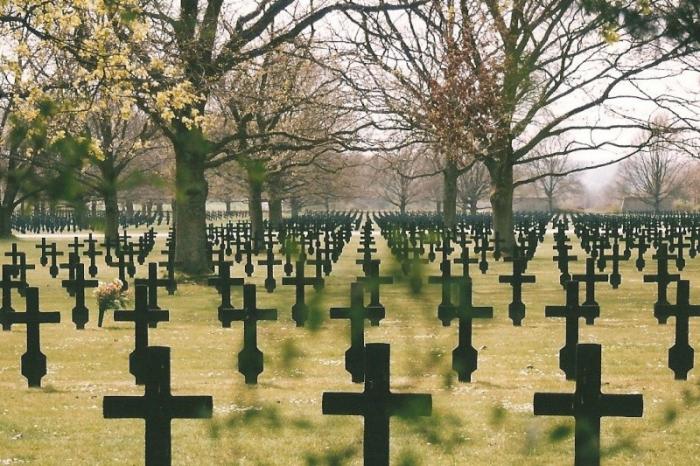
The German cemetery of La Malmaison.
Source: SGA/DMPA - JP le Padellec
The Malmaison sector battlefield lies in the western part of the Chemin des Dames northeast of Soissons, between the Aisne and Ailette.
German cemetery, 1944 The German cemetery of La Malmaison, in the western part of the Chemin des Dames, is primarily the final resting place of German soldiers killed after the 1944 Normandy landing, in particular during the Allied breakthrough at Avranche. A 1954 Franco-German convention turned the temporary site at Malmaison into a permanent German cemetery. The cemetery, which was inaugurated on 21 August 1965, has 11,841 graves. As early as 1941 special trains brought the first bodies here from sites in the Monts de l'Aisne (1940 offensive). In the summer of 1960 the French government and the German Volksbund grouped together 6,800 bodies of Wehrmacht soldiers from the six departments bordering on La Malmaison Fort and reburied them in the German cemetery of La Malmaison. The Malmaison sector battlefield lies approximately 15km northeast of Soissons in the western part of the Chemin des Dames, between the Aisne and Ailette. An important strategic position, the site was identified in the 19th century and Séré de Rivières incorporated it into his Laonnois defence system. Advances in military technology (the torpedo shell crisis) made La Malmaison Fort obsolete and it was decommissioned by the outbreak of the war, but the Germans used it when they fortified the Chemin des Dames zone.
On the French side, the high number of casualties sustained in the Nivelle offensive brought down morale and triggered mutinies. Generals Nivelle and Mangin were dismissed; Pétain replaced Nivelle. He restored the troops' trust and meticulously prepared a limited offensive in the Malmaison sector for autumn 1917. The assault started on 23 October 1917 and successfully ended three days later, restoring the army's confidence in itself and its hierarchy. The German troops fell back to the north of the Chemin des Dames, in the Ailette Valley. General Salin's 38th African Infantry Division and six divisions of 38 Schneider tanks and 30 Saint-Chamond tanks of Special Army (A.S.) nos. 8, 10, 11, 12, 31 and 33, backed up by 1,850 artillery pieces, softened up the terrain for six days before the attack, starting to pound Vauxaillon Field in Filain at 5:15am on 23 October.
A.S. 12 passed the Casse-tête and Leibnitz trenches and took the Carabine trench, but mud delayed the advance. The infantry encircled the Bohery quarries, which Colonel Bailleul's Moroccan Colonial Infantry Regiment (R.I.C.M.) took at 3pm. Major Giraud's 4th Zouaves captured La Malmaison Fort the next morning at six o'clock. The tanks of A.S. 31 and the 75th Infantry Regiment took the Fruty ravines while A.S. 11 mopped up the Vaudesson ravine and the 17th Infantry Battalion (B.C.P.), backed up by the 4th battery, captured Oubliettes trench, reaching the Chavignon Plateau. On 25 October the 14th Army Corps, with support from the Saint-Chamond tanks of A.S. 10, took the village of Pinon, while the mountain infantry entered Pargny and the 1st B.C.P. took Chavignon and Les Bruyères. The French army reached the banks of the Ailette.
The toll : 8,000 Germans were killed, approximately 30,000 wounded and 11,500 taken prisoner; 14,000 French were killed or wounded. The French captured 200 German cannons, 222 Minenwerfer and 720 machine-guns.
The Zouaves stele recalls the heroism of the 4th R.I.C.M. Zouaves, 4th Zouave Skirmishers and 3rd Skirmishers
The Algerians of the 38th Infantry Division supported by the 32nd Field Artillery Regiment (R.A.C.) commanded by Major Giraud (a future general) took La Malmaison Fort on 23 October 1917, capturing 600 German soldiers and 17 cannons.
The monument to Colonel Bailleul's Moroccan Colonial Infantry Regiment of (R.I.C.M.) pays homage to the courage and tenacity of these men in the Bohery quarries sector.
German cemetery, 1944 Volksbund Deutsche Kriegsgräberfürsorge e.V. Bundesgeschäftsstelle Werner-Hilpert-Straße 2 D 34112 Kassel Tel.: 0180 / 570 09-99 (0.12 € / min) Fax: 05 61 / 70 09-221 E-mail:
info@volksbund.de